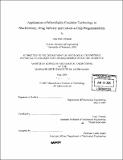Application of microfluidic emulsion technology to biochemistry, drug delivery and Lab-on-a-Chip programmability
Author(s)
Urbanski, John Paul
DownloadFull printable version (16.26Mb)
Other Contributors
Massachusetts Institute of Technology. Dept. of Mechanical Engineering.
Advisor
Todd Thorsen.
Terms of use
Metadata
Show full item recordAbstract
This research applies microfluidic emulsion technology to three diverse problems; biochemistry, drug delivery and lab-on-a-chip programmability. These subjects represent distinct research programs, but the underlying physics of droplet formation, transport and control at low values of the Reynolds and Capillary numbers in multiphase microfluidics allows them to be considered in parallel and supports the flexibility of this technology. Within these stamp-sized elastomeric polydimethylsiloxane (PDMS) microfluidic devices, pressurized immiscible fluids may be combined at a junction of two or more microchannels, combining crossflow and viscoelastic shear, to generate emulsions. Droplet sizes may be tuned from nanometers to microns in diameter, controlled by device geometry and hydrodynamic flow characteristics. The application of droplets as individual bioreactors for biochemical assays is first explored at the device and external sensor level. The goal of this research is to extend on existing approaches and address challenges of platform scalability. Microchannel design strategies are analyzed then fabricated in order to increase sample incubation periods. Using monodisperse droplet formation within microfluidic devices, techniques are developed for the manufacture of drug loaded biodegradable polymeric particles for controlled release of encapsulated ingredients within biological systems. Coupled with the bulk method of solvent evaporation, microspheres with a tunable range of volumes spanning four orders of magnitude are generated and characterized using this rapid and flexible prototyping technique. Finally, a programmable microfluidic system platform using multiphase flows in soft lithography is developed. (cont.) To demonstrate scalability of this approach, a "general- purpose" microfluidic chip is implemented, where underlying mechanisms for sample manipulation can be integrated to develop more complex systems. This research represents a first step to bring high-level control abstractions to the microfluidic realm, with the aim of enabling a new level of scalability and programmability for lab-on-a-chip experiments.
Description
Thesis (S.M.)--Massachusetts Institute of Technology, Dept. of Mechanical Engineering, 2005. Includes bibliographical references (p. 129-138).
Date issued
2005Department
Massachusetts Institute of Technology. Department of Mechanical EngineeringPublisher
Massachusetts Institute of Technology
Keywords
Mechanical Engineering.